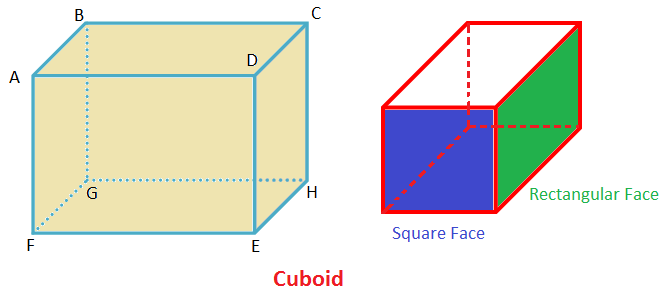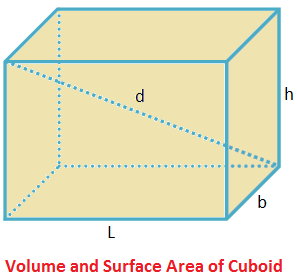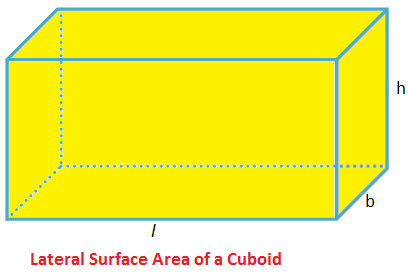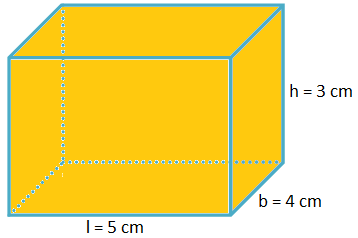Subscribe to our ▶️ YouTube channel 🔴 for the latest videos, updates, and tips.
Volume and Surface Area of Cuboid
What is Cuboid?
A cuboid is a solid with six rectangular plane faces, for example, a brick or a matchbox. Each of these is made up of six plane faces which are rectangular. Remember that since a square is a special case of a rectangle, a cuboid may have square faces too.
The
figure below shows two cuboids.
Consider the cuboid on the left. It has
1. Six rectangular faces, namely ABCD, EFGH, ABGF, CDEH, ADEF and BGHC. Its opposite faces are congruent.
2. Twelve edges, namely AB,BC, CD, DA, FG, HE, EF, AF, BG, CH and DE. The edges AB, CD, FG, EH are equal; the edges BC, AD, GH, EF are equal; the edges AF, BG, CH, DE are equal.
3. Eight Corners (or vertices), namely A, B, C, D, E, F, G and H.
4. Three dimensions: Length (l) = FE, breadth (b) = FG and height (h) = AF.
5. Four diagonals, namely AH, FC, BE and GD which are all equal. These are line segments joining opposite corners (not on the same face).
Note: The dimensions of a cuboid are a cm × b cm × c cm means the length = a cm, breadth = b cm and height = c cm.
Volume of a Cuboid (V) = l × b × h
Total surface Are of a Cuboid (S) = 2(lb + bh +hl)
Diagonal a Cuboid (d) = \(\sqrt{\mathrm{l^{2} + b^{2} + h^{2}}}\)
Where l = Length, b = breadth and h = height.
Area of the Four Walls of a Room (Lateral Surface Area of a Cuboid)
Rooms area examples of cuboids.
Are of the four walls of a room = sum of the four vertical (or lateral) faces
= 2(l + b)h
Where l = Length, b = breadth and h = height.
Problems on Volume and Surface Area of Cuboid:
1. A cuboid has three mutually perpendicular edges measuring 5 cm, 4 cm and 3 cm. Find (i) its volume, (ii) its surface area, and (iii) the length of the diagonal.
Solution:
Three mutually perpendicular edges are the length, breadth and height.
Length = l = 5 cm, breadth = b = 4 cm, height = h = 3 cm.
Therefore, (i) Volume = l × b × h = 5 × 4 × 3 cm3 = 60 cm3;
(ii) Surface area = 2(lb + bh + hl) = 2(5 × 4 + 4 × 3 + 3 × 5) cm2
= 2(20 + 12 + 15) cm2
= 94 cm2;
(iii) Length of a diagonal = \(\sqrt{\mathrm{l^{2} + b^{2} + h^{2}}}\)
= \(\sqrt{\mathrm{5^{2} + 4^{2} + 3^{2}}}\) cm
= \(\sqrt{50}\) cm
= 5√2 cm.
2. The length, breadth and volume of a cuboid are 8 cm, 6 cm and 192 cm3 respectively. Find its (i) height, (ii) surface area, and (iii) lateral surface area.
Solution:
Let the height = h.
Then, volume = l × b × h
⟹ 192 cm3 = 8 cm × 6 cm × h
⟹ h = \(\frac{192 cm^{3}}{8 × 6 cm^{2}}\)
⟹ h = \(\frac{192 cm^{3}}{48 cm^{2}}\)
⟹ h = 4 cm.
Therefore, (i) height = 4 cm.
(ii) Surface area = 2(lb + bh + hl)
= 2(8 × 6 + 6 × 4 + 4 × 8) cm2
= 2(48 + 24 + 32) cm2
= 208 cm2
(iii) Lateral surface area = 2(l + b)h
= 2(8 + 6) × 4 cm2
= 2(14) × 4 cm2
= 28 × 4 cm2
= 112 cm2
From Volume and Surface Area of Cuboid to HOME PAGE
Didn't find what you were looking for? Or want to know more information about Math Only Math. Use this Google Search to find what you need.






New! Comments
Have your say about what you just read! Leave me a comment in the box below. Ask a Question or Answer a Question.